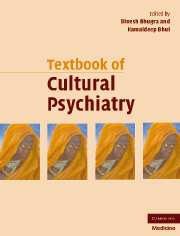Book contents
- Frontmatter
- Contents
- Contributors
- Foreword
- Preface
- Part I Theoretical background
- Part II Culture and mental health
- Part III Culture and mental disorders
- Part IV Theoretical aspects of management
- 26 Traumascape: an ecological–cultural–historical model for extreme stress
- 27 Sexual dysfunction across cultures
- 28 Therapist–patient interactions and expectations
- 29 Developing mental-health services for multicultural societies
- 30 Psychopharmacology across cultures
- 31 Psychotherapy across cultures
- 32 Psychological interventions and assessments
- 33 Spiritual aspects of management
- 34 Cultural aspects of suicide
- Part V Management with special groups
- Part VI Cultural research and training
- Cultural psychiatry: the past and the future
- Index
- References
27 - Sexual dysfunction across cultures
from Part IV - Theoretical aspects of management
Published online by Cambridge University Press: 11 August 2009
- Frontmatter
- Contents
- Contributors
- Foreword
- Preface
- Part I Theoretical background
- Part II Culture and mental health
- Part III Culture and mental disorders
- Part IV Theoretical aspects of management
- 26 Traumascape: an ecological–cultural–historical model for extreme stress
- 27 Sexual dysfunction across cultures
- 28 Therapist–patient interactions and expectations
- 29 Developing mental-health services for multicultural societies
- 30 Psychopharmacology across cultures
- 31 Psychotherapy across cultures
- 32 Psychological interventions and assessments
- 33 Spiritual aspects of management
- 34 Cultural aspects of suicide
- Part V Management with special groups
- Part VI Cultural research and training
- Cultural psychiatry: the past and the future
- Index
- References
Summary
EDITORS' INTRODUCTION
Sex and sexual dysfunction are fairly universal behaviours across cultures, ethnic groups and societies. The presentation of sexual dysfunction varies according to the cultural norms. Societies have been described as sex positive (where sex is seen as a pleasurable activity) or sex negative. Thus, within sex-positive societies, sexual activity is more likely to be for pleasure, whereas in sex-negative societies, sex is more for procreative purposes and less for personal pleasure.
Bhugra and de Silva provide an overview of some epidemiological findings of sexual dysfunctions in the West and selected cultures. The gender roles and role expectations also influence how sexual activity and sexual dysfunction are seen and how help is sought. From groups where sex is purely for procreative purposes, it is possible that women are more likely to be referred via gynaecologists and obstetricians. Thus, their motivation for treatment will also vary. Use of indigenous methods of treatment and delays in seeking help complicate matters further. The authors indicate that prevalence of sexual dysfunction will depend upon a number of factors, most of which are environmental and social. Placing sexual dysfunction and its management in the cultural context means that the outcome can be improved. The affective states and cognitive schema also vary across cultures, thereby making the task of the therapist more difficult.
Introduction
Sex is one of the basic human instincts and over the centuries its functions have shifted from procreation to pleasure.
- Type
- Chapter
- Information
- Textbook of Cultural Psychiatry , pp. 364 - 378Publisher: Cambridge University PressPrint publication year: 2007
References
- 2
- Cited by



